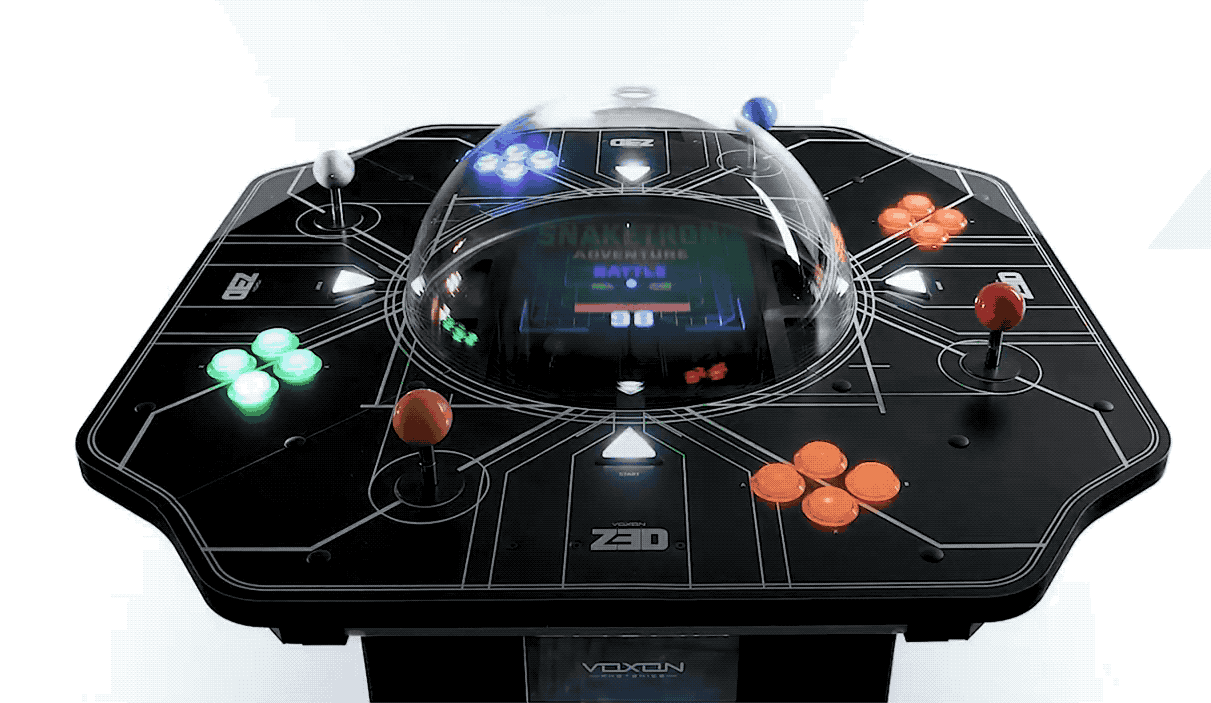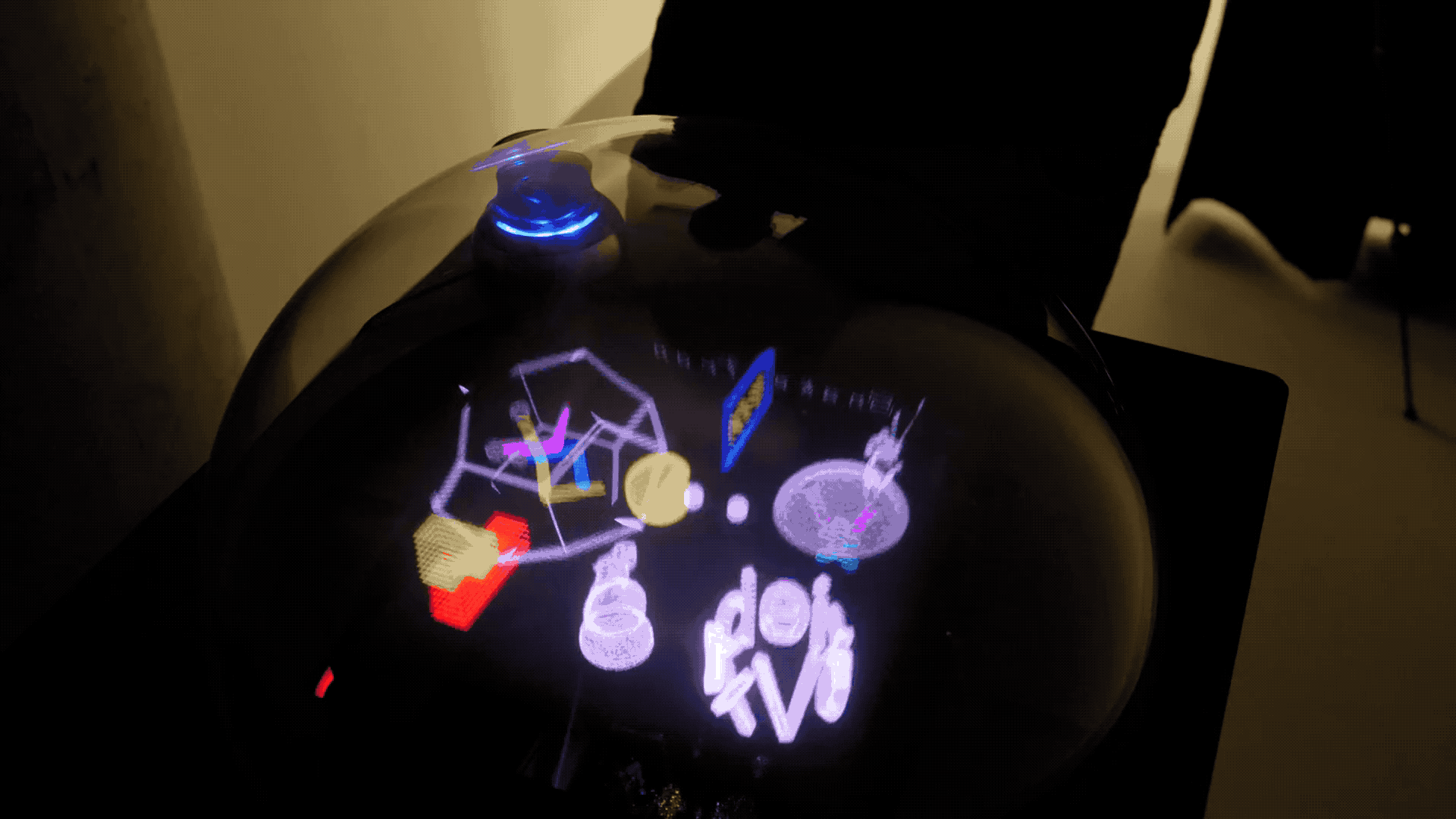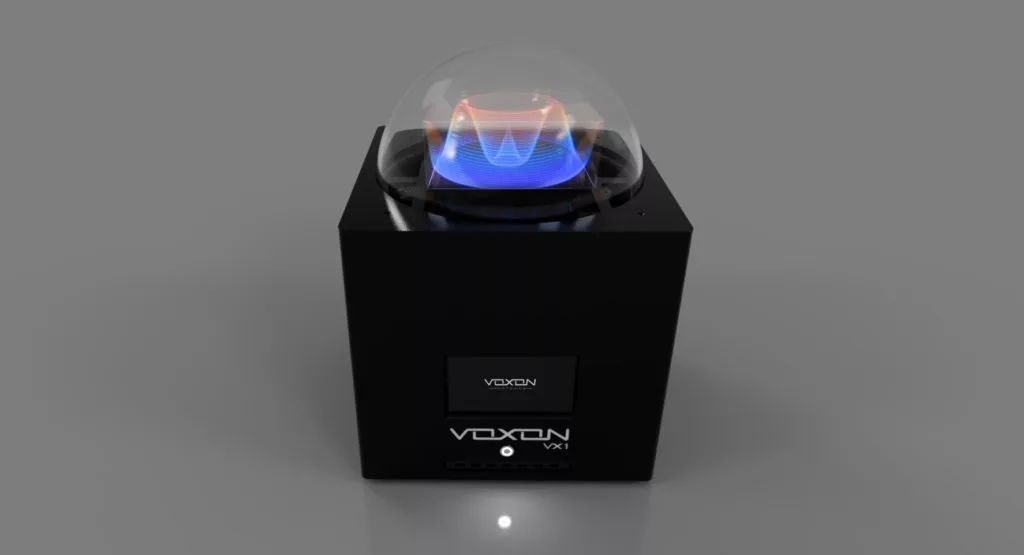Interactive 3D images that appear to float in the air, above a table that a group of people can stand around without needing any special headsets or glasses: that's what South Australian company Voxon Photonics has built with its US$10,000 VX1 table.
Fiction has promised us holograms for decades, with one of the most famous examples appearing in 1977's Star Wars: A New Hope. On board the Millennium Falcon, R2D2 and Chewbacca play some sort of digital board game, interacting with figures built out of light hovering in the air above a table.
Such things have been a long time coming to the real world. VR and AR can both somewhat replicate the experience, but they require headsets. In the best case, these are a bit antisocial, stopping you from looking others in the eye. In the worst case, they completely remove the wearer from the real world to immerse them in virtual space.
The VX1 table from Voxon Photonics, on the other hand, requires no headset or eyewear. It operates more or less exactly like the hologram table in Star Wars, albeit usually with a glass dome over the top of it, and can display an 18x18x8 centimeter holographic image, video, game or interactive data visualization.
I videocalled Voxon CEO/CTO Gavin Smith to ask how the company achieved it, and was treated to a look around the company's Adelaide offices to see a couple of different types of devices in action.

How does it work?
The VX1 table can best be described as 3D printing its image in the air. It breaks a 3D form up into horizontal layer slices, then achieves the mind-bending trick of projecting these slices onto a single piece of rear projection glass that's being flung back and forth in the air at 15 cycles per second on a set of harmonic resonance springs.
The system tracks the location of the glass and synchronizes it perfectly with a 4,000 frames per second projector, so that each slice is projected at exactly the right height. The slices are stacked and re-stacked so fast that your eyes can't track the motion, and an object appears to float in the air. Since it's being re-drawn both on the up and down swing of the glass, you get a hologram video refresh rate of 30 frames per second, and the illusion is terrific.
Constantly slicing and re-slicing a moving 3D space, synchronizing the projection and dealing with things like projector beam divergence, multiple color projections and all sorts of other issues – this requires some pretty epic programming and processing chops. Indeed, Smith tells us, it required "the world's best programmer" to execute what the VX1 table can in real time, a title he was happy to give either to John Carmack, lead programmer on id Software's Doom and Quake, among many others, or Carmack's early rival Ken Silverman, who created the Build engine used to power Duke Nukem, among other games, back in the 1990s.
With Carmack wrapped up in a different project - you may have heard of Oculus Rift - Smith was delighted to bring Silverman on board as a Voxon co-founder back in 2013, and Silverman has served as Voxon's chief computer scientist ever since.

What can it do?
As a volumetric display, it can show more or less whatever you like within the swept area of that projector sheet. In the case of the VX1 table, the screen is around 18x18x8 cm (~7x7x3 inches). Going much bigger starts making it difficult to move the glass fast enough to create a solid illusion, but Voxon has a solution for bigger installations, which we'll get to later.
Smith says it's already working well for games, mapping data, presentations and medical imaging. For games, it natively supports the Voxatron engine, with plug-ins for Unity and Kinect, among other things, to display existing games. For medical imaging, it's compatible with DICOM imaging like you'd get out of a CT scanner – indeed, it does things you can't do on a PC, like allowing you to sweep through density zones, so you can dissolve an image between the bones, muscle tissue, organs and blood vessels in real time.
"You can't do that with PC software, it's not fast enough," says Smith. "Our software is very advanced. A lot of that's down to having Ken running the software team working on the DLL. His expertise in low-level programming is world class."
"We're also piggybacking on a lot of the volumetric data that's being captured for VR and AR by Intel, Microsoft and all these big VR capture labs," he continues. "These guys are capturing 3D volumetric data of a whole video scene. So you can walk around it in VR, but we can present it in an alternative medium."
Smith is keen to make volumetric content a social thing, something like a "digital campfire," and speaks of potential pub tables that could stream live sports events or music performances right onto the table. "The technology to capture that is already here," he tells us, "Intel is already doing that with sport capture rigs – photogrammetry that's converted into a mesh. There's companies all over America doing 3D captures of music videos. They're thinking VR and AR, but we could do the same thing as a device in a bar for replaying that kind of stuff."

Smith sees advertising as another key opportunity; the ability to have interactive 3D models of a car, or watch, or product popping up on the table in between plays or songs. And he feels the volumetric display can also be a terrific teaching tool if it's tailored right, allowing highschoolers to visualize molecules and atoms, or insect anatomy, or terrain maps: "There's a real interest from schools and universities. The real difficulty there is making it simple enough for the teachers to run themselves without having to skill up. Teachers are already overburdened with other things like keeping chaos at bay. They need to have lesson plans and whatnot curated for them a bit more." At a university level, the system could be handy in demonstrating complex concepts in a way that a group of people can watch together and discuss in a meaningful manner.
It's already working as a face-to-face holographic videophone, using a Kinect camera from an XBOX to capture faces in 3D, and live-streaming the results between callers as far apart as London and Adelaide. And of course, there's a ton of opportunities in casinos, military applications, and things like concept cars that inspire people to think futuristic. Making it work in an actual moving car, on the other hand, would be a serious challenge.

How about scaling up?
Voxon's glass shaker might not scale up well – bigger versions are much harder to shake back and forth at a rate that gives you a satisfying video frame rate – but the company has another trick or two up its sleeve. Using a rotating screen that looks something like a drill bit, with ramps and drop-offs, it's possible to make a much larger volumetric display that relies on projectors coming down from above.
Smith shows me a small prototype, and the illusion is every bit as compelling on the rotating screen as the reciprocating one, even over Skype – with the exception of a dead spot in the middle where the surface isn't moving fast enough to maintain the illusion. It shows up as a vortex-like hole in the image. Content will need to be created with this in mind.
Executing a rotating display has brought its own additional challenges and complexities for Silverton and the Voxon team. "This one uses a helical slicing algorithm instead of a linear slicing algorithm," says Smith. "And we're aligning three projectors, red, green and blue, into the same space. The keystone calibration's pretty complicated, you can see some pink fringing around these icons, we're working on that."
Each version has its particular foibles, but both create a compelling volumetric display, and the spinning one can deliver higher frame rates.
Are the videos fake?
No. It's true that VR and AR systems, as well as glasses-based systems like Euclideon's hologram tables, require CGI to layer the virtual images onto the real footage, but the physical way in which the VX1 table works means that you can film it with a regular camera and experience the effect. All the images and footage you see here are unedited.
"People looking at the video and saying it's fake is actually a bit of a compliment," says Smith, "because it means they think it's not possible. They think it's CGI. But as a company, we've never used any CGI or compositing, we show our actual hardware. The only trick we use is filming it with a Panasonic GH5, which allows us to film at 15 frames per second, so we don't get a rolling shutter effect and it all looks super crisp. When people film it on iPhones, it looks like it'll give people an epileptic fit, but that's just because of the frame rates."

The VX1 Table
As Voxon continues to work on its alternative displays, the VX1 table has been thoroughly productized and is already on sale for around US$10,000 per unit. Smith says the team has refined the design through many generations to be just about bulletproof – and demonstrates by slapping his hand down on a VX1's reciprocating screen, stopping it dead. Taking his hand off, he starts it up again easily.
"The parts that do have a wear profile, like the springs," he says, "we've done FEA analysis and simulated their breakages, and that's nicely lined up with their actual breakages, something like 500 hours of running. Those parts are now consumable parts that people can swap in and out in five or ten minutes, like a printer cartridge. Very little technical capability required."
The company's not ready to go into huge production runs just yet, so it's qualifying its early customers, aiming to get VX1s into the hands of people that will use them effectively and make sure plenty of others get to see them. Enjoy a video below.
Source: Voxon Photonics








